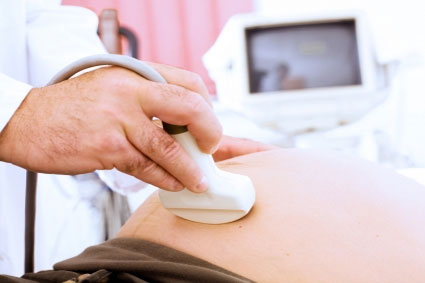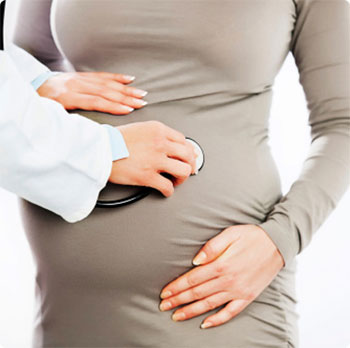CONVENTIONAL & LAPAROSCOPIC GYNAECOLOGICAL PROCEDURES
Laparoscopic surgery is a modern surgical technique in which operations in the abdomen are performed through small incisions as compared to the larger incisions needed in laparotomy (open surgery). Keyhole surgery uses images displayed on TV monitors for magnification of the surgical elements. A telescope with a sophisticated medical grade camera attached to it is introduced in to the abdomen and the organs are viewed on a high r is carried out by looking at monitor.
The video camera becomes a surgeon's eyes in laparoscopy surgery.

Laparoscopic surgeries in gynaec problems...
Laparoscopic Myomectomy (Removal of fibroids laparoscopically)
Laparoscopic hysterectomy (Removal of uterus laparoscopically)
Laparoscopy for Ovarian cysts (Removal of cysts in ovaries laparoscopically)
Pelvic organ prolapse
Treatment of ectopic pregnancy (pregnancy outside the uterus)
Diagnosis of Infertility laparoscopically
Laparoscopic sterilization

Laparoscopic Myomectomy (Removal Of Fibroids Laparoscopically)
Fibroids are benign tumours of the uterus which occur in 25 % of women in the reproductive age group:
20 - 50 yrs. The symptoms are usually excessive bleeding during periods, heaviness, pain, and if large then lump in the abdomen and depending on where the pressure is difficulty in passing urine and constipation.
Laparoscopic fibroids removal is a very patient friendly surgery. The fibroid is separated from the uterus, the capsule is sutured and finally they are removed with the help of an instrument called morcellator. Performed correctly the average time taken for the surgery, bleeding and post-operative pain is minimal and requires only one day hospital stay. Depending on the size of the fibroids and expertise of the surgeon, one can remove them with a single incision near the umbilicus.
To summarize laparoscopic removal of fibroids is the most patient friendly surgery for women with fibroids and is the best choice. The expertise of the surgeons, safety of anaesthesia, teamwork and the quality of equipment remains and determines the hallmarks of good outcome.
Laparoscopic Hysterectomy (Removal Of Uterus Laparoscopically)
Hysterectomy is the surgical removal of the uterus (womb) and is performed when a woman has health problems related to it after her child bearing is complete (> 45 years of age). The common reasons are fibroids (non-cancerous tumours of the uterus), heavy bleeding during periods, prolapsed (condition in which the uterus moves down from its normal position), endometriosis (presence of the lining of the uterus in nearby organs causing severe pain and bleeding) and cancer of the uterus and cervix.
In most of the cases, it is done through key hole surgery except in very few patients where uterus is so big where there is no place for putting laparoscope and other instruments in to the abdomen. In hysterectomy, the uterus and its supports are separated with special equipment, which reduce blood loss and time of surgery. The uterus is then removed through the birth passage or if it is large removed by morcellation. After hysterectomy, a woman will no longer have her periods.

Laparoscopy For Ovarian Cysts (Removal Of Cysts In Ovaries Laparoscopically)
Ovarian cysts are small fluid-filled sacs that develop in a woman's ovaries. The cysts can be simple cyst they will disappear in most of the cases only observation is needed, this is common younger age group, other type is benign or non-cancerous cysts, these need close monitoring and surgery is needed in most of the cases due to large size or torsion or due to fear of turning in to malignancy (cancer) other type is cancerous cyst in they need surgery. Most cysts are harmless, but some may cause problems due to rupturing, bleeding, or torsion.
These symptoms can be
Fullness in the abdomen
Painful periods and abnormal bleeding
Problems passing urine completely
Pain with fever and vomiting
A laparoscopic surgery can be done for most of these ovarian cysts except in advanced ovarian cancer cysts. The laparoscope is then used to locate the cyst. Once located, one or two more tiny incisions are made, through which surgical instruments are inserted to remove the cyst. The cyst can be removed intact or it can be aspirated and cyst wall can be either excised or ablated. The removed tissue should be sent for biopsy.
Surgery For Pelvic Organ Prolapse
Pelvic prolapse is a weakness or laxity in the supporting structures of the pelvic region. Bladder, rectal, or uterine tissue may then bulge into the vagina. This is called pelvic organ prolapse Pelvic organ prolapse is a very common condition, particularly among older women. It's estimated that half of women who have children will experience some form of Pelvic Organ Prolapse in later life. A Prolapsed Uterus refers to a collapsed uterus, or descended uterus, or other change in the position of the uterus in relation to the surrounding structures within the pelvis. The Various Types of Pelvic Organ Prolapse.
Cystocoele (bladder prolapse)
Rectocoele (rectal wall prolapse)
Enterocoele (prolapse of the small bowel)
Uterine prolapse
Vaginal vault prolapse (prolapse following hysterectomy)

But excellent care requires more than the latest technology and the most current advances in evidence-based medicine. We take pride in providing a caring and compassionate environment for our patients and their babies.
Ectopic Pregnancy
It's a pregnancy that develops outside the womb, usually in one of the fallopian tubes. That is why it is also known as a tubal pregnancy, even it can grow in the ovaries, abdomen. It happens in about two of every 100 pregnancies in India. As the pregnancy grows, it causes pain and bleeding and, if not recognized, the tube can rupture, causing internal bleeding. This is a medical emergency and can be fatal.
Causes of ectopic pregnancy
Pelvic infection
Tubal endometriosis
Previous abdominal surgeries
Intra uterine contraceptives
Usually these patients present with one-sided pain in the lower abdomen that is severe and persistent is the most common symptom. Many women describe it as an intense stabbing pain.
Collapse, preceded by feeling faint, dizziness, diarrhoea, vomiting and/or pain.
Vaginal bleeding. You might not know that you're pregnant and mistake this for a period, but the blood is usually different from a normal period - often dark and watery.
Shoulder-tip pain. This can happen if there is internal bleeding which irritates other internal body organs, such as the diaphragm.
Pain in the lower back.
Pain when having a wee or opening your bowels.
Treatment options for ectopic pregnancy include observation, laparoscopy, laparotomy. For those who require intervention, the most common treatment is surgery. Laparotomy is an open procedure whereby a transverse incision is made across the lower abdomen. For many surgeons and patients, laparoscopy is preferred over laparotomy because of the tiny incisions used and the speedy recovery afterwards. Under optimal conditions, a small incision can be made in the Fallopian tube and the ectopic pregnancy removed, leaving the Fallopian tube intact. In some instances, the location or extent of damage may require removal of a portion of the Fallopian tube, the entire tube, the ovary, and even the uterus.
However, certain conditions make laparoscopy less effective or unavailable as an alternative. These include massive pelvic scar tissue and excessive blood in the abdomen or pelvis.
Laparoscopy For Infertility
This procedure allows us to determine the abnormalities of the uterus, fallopian tubes and ovaries whether there are any defects such as scar tissue, endometriosis, fibroid tumors, congenital abnormalities and polycystic ovaries and other.
In some women the fallopian tubes are blocked. This can prevent sperm and egg from coming together, causing infertility .With laparoscopy, if any defects are found then they can sometimes be corrected with operative laparoscopy which involves placing instruments through ports in the scope and through additional, narrow (5 mm) ports.

Laparoscopic Sterilization
Laparoscopic Sterilization or Tubal ligation also known as "tying the tubes" is surgery to close a woman's fallopian tubes so that she can no longer get pregnant.
The fallopian tubes are on either side of the uterus and extend toward the ovaries. They receive eggs from the ovaries and transport them to the uterus. Once the fallopian tubes are closed, the man's sperm can no longer reach the egg. Stertilization can be done with laparoscopy or mini laparotomy in this abdomen is cut about 3-4 cm. Inlaparoscopy complete tubal ligation by making a small incision near the navel.
A special device for grasping the fallopian tubes is inserted through a second, small incision made at the pubic hairline. The fallopian tubes are sealed in one of two ways: with an electric current that makes the tube clot (electrocoagulation) or with a band or clip that is placed over the tubes. Your physician may also cut the fallopian tubes. After the fallopian tubes have been sealed, the laparoscope and grasping device are removed and a small bandage is applied over the incisions.
